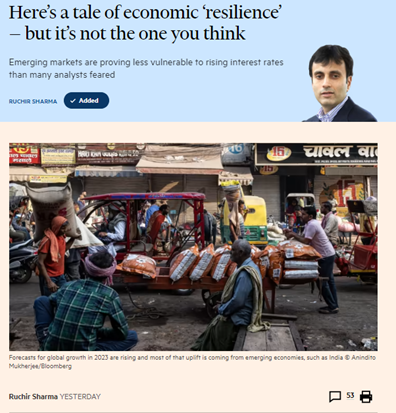If you would like to receive weekly updates like this, sign up here.
Imagine for a moment you are the leader of a developing economy.
One day you visit a global infrastructure investment bank looking for funds to improve your nation’s infrastructure.
When you walk back out again, what would you prefer to be leaving with?
Funds for a new airport or a lecture on poor governance?
These were the terms used by a developing country figure on the difference between dealing with the Chinese and the Western powers for investment funds. The Chinese will open their wallets, not questions asked. Western institutions will tell people to clean up their acts first.
Anecdotes aside, this underlines a more far reaching and strategically important race going on between East and West.
Best highlighted by two of the most important drivers emerging today.
They are: access to loans and infrastructure spending.
Why are these important to you?
Because both represent crucial movements of the 18.6-year Real Estate Cycle during the 2nd more speculative half of this current cycle.
And so, exclusively for you as a regular Property Cycle Investor (PCI) newsletter reader, I’ve a surprise for you.
Front row seats if you will to an important event.
As a budding student of the real estate cycle, it’s one I’m sure you’ll appreciate.
Let’s look now.
The turning of the clock.
And now…. rejoice!
You are the first to witness it.
What am I referring to? The turning of the proprietary Property Sharemarket Economics (PSE) property clock. We have officially moved the hour from 1300 to 1400.
Source : PSE
This means that it’s a key time in the life of this current real estate cycle.
1400 on the clock stands for this – “Lavish government spending for public works.”
This is the difference between being a member of PSE and relying on the mass media for your news.
Whilst they have been solely focused on dialing up the rhetoric and negativity around interest rates and inflation, the PSE team is paying attention to the true trigger moments of the cycle.

Source – FT
It’s the incredible amount of money flowing into global infrastructure that confirms the time is right to move our clock up. Three quarters of the 25 biggest emerging economies have beaten growth forecasts for 2023 so far.
Forecasts for global growth in 2023 are rising and most of that uplift is coming from emerging economies. And money follows growth: foreign investment in the big emerging markets is on the rise. Their currencies have been strengthening against the dollar since late last year.
Which is why you should take more than a passing glance at the strategically important events happening across emerging and developing countries around the world.
Because the spending (or, more accurately, money creation) for the remainder of this decade won’t simply be government spending to open a brand-new public library near your own residence.
Though they will still do that!
Rather it will encompass widespread leveraging of public money and turn that into developing country loans that can help pay for much needed green infrastructure and public service commitments.
Recall China has already made substantial investments in this space during the current real estate cycle with their Belt and Roads Initiative (BRI).
They provided credit, the labor and engineering expertise to allow for some long overdue and impressive infrastructure projects.
With developing countries’ borrowing costs rising but massive green infrastructure spending needed, the US and the EU are now trying hard to match Beijing’s offer of investment.
Washington merged federal agencies to create the International Development Finance Corporation (DFC) in 2018, and at the G7 rich nations meeting in 2021 President Joe Biden launched a Build Back Better World initiative, now called the Partnership for Global Infrastructure and Investment (PGII).
The EU in 2021 launched its Global Gateway, whose aims align with these US based initiatives by grants, federal funds, and private investment to the tune of $200 billion USD.
Added to what the PGII has pledged this should total almost $700 billion USD by 2027.
If you consider just the US ‘s own domestic infrastructure programmes announced two years ago are expected to easily exceed $2 trillion USD in the same timeframe, and the numbers are staggering.

Never in history has so much been pledged to infrastructure programs in such a short time span.
Then to expand your mind even more, this doesn’t include the trillions of yuan spent via China’s BRI to countries as diverse as Russia, Pakistan, Zambia, Sri-Lanka.
But as I’ve written to you from the beginning of 2023, this year would see incredible resources and credit poured into a global infrastructure bonanza. Finally, it appears the West has decided it’s time to stop talking and lecturing – and start spending.
All this spending will affect you, regardless of where you reside. But history shows us once the PSE property clock turns to 1400 what comes next, and more importantly – when.
And you can know too if you take up a membership to the Boom Bust Bulletin (BBB). Give me the opportunity to take you in depth into the cycle.
Learn about the history of both the 18.6-year Real Estate Cycle and the Kondratieff wave and why even today both continue to repeat like clockwork.
It will teach you how to decipher the news that we get bombarded with every day to focus solely on what truly matters.
No more negativity and noise, just the science of the economic rent and the timing inherent in the real estate cycle.
This is all you need to succeed.
Don’t allow the mass media to box you in with negative stories focused solely on inflation and interest rates.
Instead, lift your line of sight above all that and witness the world for what’s truly happening.
And what’s happening is this: the biggest boom in human history is kicking off.
It’s hardly my fault that most seem to want you to not know this.
Nonetheless, the turning of the PSE property clock is now justified and arguably a bit overdue.
Which means the investment choices you make to expose your capital to this spending must be aligned with the real estate cycle and timely too.
That’s how the BBB can help.
As a Boom Bust Bulletin member you will receive 12 monthly editions a year detailing all the key turning points of the cycle, a deep dive into the most important markets across the globe and ways that you can personally benefit from this knowledge.
All derived from our unique and proprietary research – which you’ll not find anywhere else.
Plus, you’ll receive exclusive invites to BBB member-only webinars when we run them.
All this for just US $4 a month, less than a takeaway coffee.
Best wishes,

Darren J Wilson
and your Property Sharemarket Economics Team
P.S. – If you would like to receive weekly updates like this, sign up here.
P.P.S – Find us on Twitter here and go to our Facebook page here.
This content is not personal or general advice. If you are in doubt as to how to apply or even should be applying the content in this document to your own personal situation, we recommend you seek professional financial advice. Feel free to forward this email to any other person whom you think should read it.



